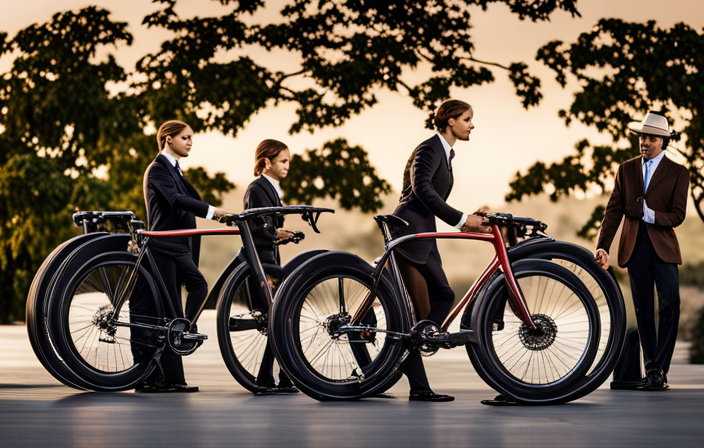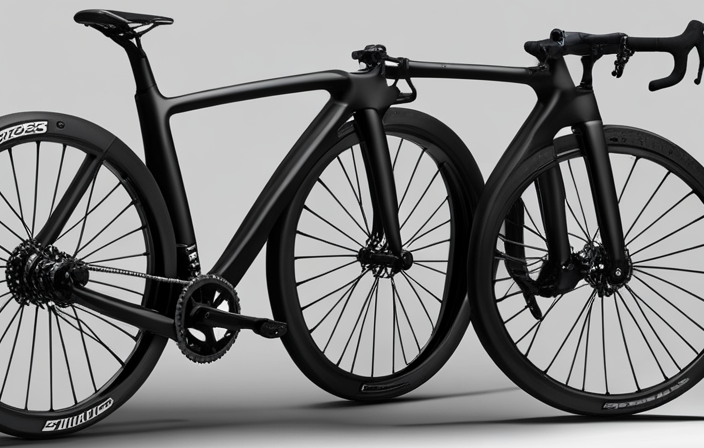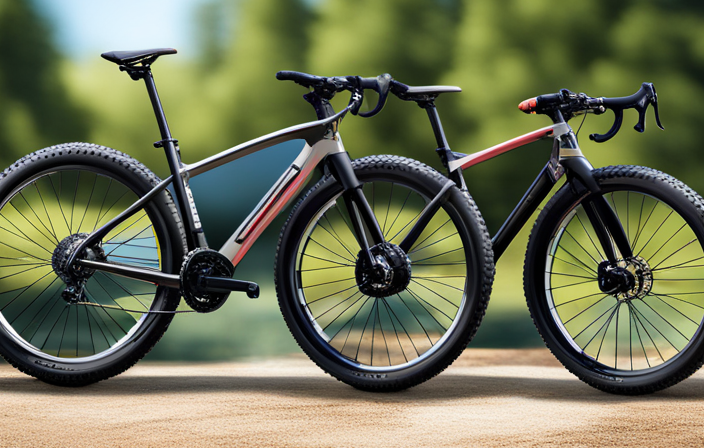Were you aware that by 2027, the worldwide bicycle market is anticipated to achieve a valuation of $75.39 billion?
With so many options available, it can be overwhelming to choose the right bike for your needs.
In this article, we will explore the key differences between gravel bikes and hybrid bikes.
From frame design to tire size and gearing, understanding these distinctions will help you make an informed decision and find the perfect bike for your riding adventures.
Key Takeaways
- Gravel bikes have longer wheelbase and lower bottom bracket height, while hybrid bikes have shorter wheelbase and higher bottom bracket height.
- Gravel bikes have wider tires with more aggressive tread patterns, providing better traction on loose surfaces, while hybrid bikes have narrower tires with less aggressive tread patterns, suitable for paved roads and urban commuting.
- Gravel bikes offer optional front suspension for off-road riding, providing a smoother and more comfortable experience on rough terrains, while hybrid bikes typically have rigid forks for efficient transfer of power on paved roads.
- Gravel bikes have drop handlebars for multiple hand positions, improving comfort and control during long rides, while hybrid bikes have flat or riser handlebars for an upright riding position, prioritizing comfort and stability.
Frame Design and Geometry
The difference between a gravel bike and a hybrid bike lies in their frame design and geometry. These factors greatly affect the bike fit and handling characteristics. Gravel bikes typically have a longer wheelbase and lower bottom bracket height compared to hybrid bikes. This results in more stability and control, especially when riding on rough terrains or off-road trails.
On the other hand, hybrid bikes are designed with a shorter wheelbase and higher bottom bracket height, making them better suited for smooth roads and city commuting.
In terms of bike fit, gravel bikes usually have a more aggressive riding position with a lower stack height and longer reach. This allows for better power transfer while maintaining aerodynamics on long rides. Hybrid bikes, on the other hand, offer a more upright riding position that provides comfort for leisurely rides or commuting.
When transitioning into the subsequent section about tire size and tread, it’s important to note that these aspects are also influenced by frame design and geometry. The differences in tire clearance between gravel bikes and hybrid bikes play a significant role in determining their respective capabilities on different surfaces.
Tire Size and Tread
When it comes to tire size and tread, gravel bikes and hybrid bikes have distinct variations. The tire size of a bike can greatly impact its performance on different surfaces. Gravel bikes typically have wider tires compared to hybrid bikes. These wider tires provide better traction on loose surfaces such as gravel or dirt roads. They allow the bike to grip the terrain more effectively, providing stability and control while riding.
In terms of tire pressure, gravel bikes often require lower pressures compared to hybrid bikes. This is because the wider tires of a gravel bike can absorb more bumps and shocks, resulting in a smoother ride. Lower tire pressure also helps increase traction on rough terrains by allowing the tires to conform to uneven surfaces.
On the other hand, hybrid bikes usually have narrower tires with less aggressive tread patterns compared to gravel bikes. This makes them more suitable for paved roads and urban commuting where speed and efficiency are prioritized over off-road capabilities.
Moving forward into the next section about suspension, we will explore how gravel bikes and hybrid bikes differ in terms of their suspension systems.
Suspension
When it comes to suspension, gravel bikes offer the option of front suspension for off-road riding, providing a smoother and more comfortable experience on rough terrains.
On the other hand, hybrid bikes typically have rigid forks that are better suited for paved road riding as they provide a more efficient transfer of power from the rider’s pedaling to the wheels.
The choice between these two options ultimately depends on your preferred riding style and the type of terrain you plan on tackling.
Gravel bike’s optional front suspension for off-road riding
If you’re looking to tackle off-road trails, a gravel bike with optional front suspension might be the perfect choice. Here are three reasons why:
-
Improved traction: With a gravel bike’s front suspension, you can adjust the tire pressure for optimal off-road performance. Lowering the pressure increases tire contact with uneven surfaces, providing better grip and reducing the risk of slipping.
-
Enhanced comfort: The optional front suspension absorbs shocks and vibrations encountered during off-road riding. This feature helps reduce fatigue and allows for a smoother and more enjoyable ride on rough terrains.
-
Increased control: The front suspension of a gravel bike improves handling by keeping the front wheel in contact with the ground, even on bumpy trails. This stability enables better control over your bike, especially when navigating through obstacles or corners.
Transitioning into the subsequent section about hybrid bikes’ rigid fork for paved road riding, it’s important to consider another aspect of bike design that affects on-road performance.
Hybrid bike’s rigid fork for paved road riding
The rigid fork on a hybrid bike provides a smooth and stable ride on paved roads. The lightweight construction allows for efficient pedaling and quick acceleration, making it ideal for commuting or leisurely rides on well-maintained surfaces.
Unlike gravel bikes, which are designed for off-road riding, hybrid bikes have narrower tires and lower tire clearance. This allows them to handle paved roads with ease, providing a comfortable and responsive ride. The rigid fork enhances stability while minimizing vibrations, ensuring a pleasant experience even on rougher sections of pavement.
Now let’s move on to discuss another important feature of both gravel bikes and hybrid bikes: the handlebars.
Handlebars
When it comes to handlebars, gravel bikes and hybrid bikes offer different options.
Gravel bikes typically have drop handlebars, which provide multiple hand positions for improved comfort and control during long rides.
On the other hand, hybrid bikes usually come with flat or riser handlebars that promote an upright riding position, ideal for leisurely commutes or casual cycling.
The choice of handlebars is an important consideration when deciding between these two bike types as it can greatly affect your riding experience.
Gravel bike’s drop handlebars for multiple hand positions
One advantage of gravel bikes is their drop handlebars, which provide multiple hand positions. These handlebars offer a variety of ways to hold onto the bike, allowing for better comfort and control during long rides. The gravel bike’s handlebar options include the hoods, drops, and tops, each providing a different grip position suitable for various riding conditions. This versatility is especially beneficial when tackling different terrains such as rough trails or smooth roads.
In contrast, hybrid bikes often feature flat or riser handlebars that promote an upright riding position. While this can be comfortable for leisurely rides or city commuting, it may limit the handling capabilities on more challenging off-road adventures.
Transitioning into the subsequent section about hybrid bike’s handlebars provides insight into another key aspect of these versatile bicycles.
Hybrid bike’s flat or riser handlebars for an upright riding position
Hybrid bikes typically have flat or riser handlebars, allowing riders to maintain an upright position while cycling. These handlebar options are designed for comfort and stability, making them ideal for leisurely rides or commuting in urban areas.
Unlike gravel bikes with drop handlebars that offer multiple hand positions for off-road capabilities, hybrid bikes prioritize a more relaxed riding experience. The flat or riser handlebars provide better control and visibility in traffic, as well as easier maneuverability through crowded streets.
Additionally, the upright position helps reduce strain on the back and neck during longer rides.
Now let’s shift our focus to another important aspect of bike design: gearing.
Gearing
The gearing on a gravel bike allows for better performance on rough and uneven terrain. The combination of gearing efficiency and gear range options provides the rider with the ability to tackle various inclines and terrains with ease.
When it comes to gearing efficiency, gravel bikes typically have a wider gear range compared to hybrid bikes. This means that you can find the perfect gear ratio for both climbing steep hills and cruising along flat roads. With more gears to choose from, you can maintain a consistent cadence regardless of the terrain you’re riding on.
To give you an idea of the gear range options available on a typical gravel bike, here’s a table showcasing some common setups:
| Front Chainring | Rear Cassette | Gear Ratio |
|---|---|---|
| 46/30 | 11-34 | 0.82:1 |
| 48/32 | 11-36 | 0.85:1 |
| 50/34 | 11-40 | 0.87:1 |
| 52/36 | 11-42 | 0.88:1 |
As you can see, these setups offer a wide range of gear ratios, allowing you to smoothly transition between different levels of resistance.
With an understanding of how gearing plays a crucial role in gravel biking, let’s now transition into discussing the next topic – weight – which also contributes significantly to overall bike performance without compromising durability or comfort.
Weight
When it comes to weight, the main focus is on achieving a balance between performance and durability without sacrificing comfort. A lighter bike can provide better acceleration and climbing ability, while a heavier bike may offer more stability and durability.
Here are four key factors to consider regarding weight when comparing gravel bikes and hybrid bikes:
-
Frame material: Gravel bikes often have lighter frames made from carbon fiber or lightweight aluminum. Hybrid bikes usually feature heavier steel or aluminum frames, which prioritize durability over weight.
-
Wheel size: Gravel bikes typically have larger wheels, such as 700c or 650b, which contribute to a lighter overall weight compared to the smaller wheels commonly found on hybrid bikes.
-
Components: The choice of components can significantly impact the weight of a bike. Gravel bikes often come with high-end components that are designed for efficiency in gearing and reduced weight, while hybrid bikes may have more basic components that add extra pounds.
-
Comfort level: While a lighter bike can enhance performance, it may also sacrifice some comfort due to increased road vibration transfer. Hybrid bikes tend to prioritize comfort by featuring wider tires and more relaxed geometry.
Considering these factors will help you determine the ideal weight for your riding style and preferences. Transitioning into the next section about versatility, let’s explore how these two types of bikes excel in different riding scenarios without compromising their strengths.
Versatility
To fully understand the versatility of these two types of bikes, consider how they excel in different riding scenarios without compromising their strengths.
Gravel bikes are designed to handle various terrains, making them perfect for bikepacking adventures. With wider tires and a more relaxed geometry than road bikes, gravel bikes can tackle off-road trails with ease. They offer stability and control on uneven surfaces, allowing riders to confidently navigate through challenging terrain.
On the other hand, hybrid bikes are more suited for urban commuting and light off-roading. They have narrower tires compared to gravel bikes, which makes them faster on paved roads. Hybrid bikes also tend to have a more upright riding position for enhanced comfort during long rides or city commutes.
When it comes to off-road racing, gravel bikes have an advantage over hybrids due to their wider tire clearance and ability to handle rougher terrain. This makes them ideal for those seeking speed and agility on unpaved tracks.
In conclusion, while both gravel bikes and hybrid bikes offer versatility in different ways, gravel bikes are better suited for bikepacking adventures and off-road racing. However, hybrid bikes still excel in urban environments and provide a comfortable ride for various purposes.
Moving forward into the next section about ‘brakes’, it’s important to note how the braking systems differ between these two types of bicycles…
Brakes
When it comes to brakes, gravel bikes have the advantage with their disc brakes, providing better stopping power in all conditions. These brakes are designed to perform well on varying terrains, making them ideal for off-road adventures.
On the other hand, hybrid bikes offer a choice between rim or disc brakes depending on the specific model, allowing riders to choose the braking system that best suits their needs and preferences.
Gravel bike’s disc brakes for better stopping power in all conditions
Gravel bikes have disc brakes, providing better stopping power in all conditions. This is a key advantage over hybrid bikes with rim brakes. Here are three reasons why gravel bike’s disc brakes excel:
-
Off-road traction: Gravel bikes allow for lower tire pressure, providing increased traction on rough terrain. The disc brakes enhance control and responsiveness when navigating challenging surfaces.
-
Wet weather performance: With disc brakes, gravel bikes offer consistent braking even in wet conditions. The rotors displace water more effectively than rim brakes, ensuring reliable stopping power regardless of weather.
-
Heat dissipation: Disc brakes handle heat better than rim brakes due to their larger surface area and improved airflow around the rotor. This prevents overheating during prolonged descents, maintaining optimal braking performance.
Transitioning into the next section about hybrid bikes’ braking systems, it’s important to note that they typically come with either rim or disc brakes depending on the model.
Hybrid bike’s rim or disc brakes depending on the model
Gravel bikes are known for their impressive braking power, thanks to the disc brakes that offer consistent stopping performance in all weather conditions.
However, when it comes to hybrid bikes, the type of brakes can vary depending on the model you choose. Some hybrid bikes come equipped with rim brakes, which use pads that press against the wheel rims to slow down or stop the bike.
On the other hand, certain hybrid bike models feature disc brakes similar to those found on gravel bikes. These disc brakes provide reliable and efficient stopping power, giving riders more control and confidence on various terrains.
When considering a hybrid bike, it’s important to check whether it has rim or disc brakes, as this can greatly impact its braking performance and overall riding experience.
Now let’s move on to discussing the price range of these two types of bicycles…
Price Range
To determine the price range, you’ll need to consider the differences between a gravel bike and a hybrid bike. When it comes to price comparison, it’s important to note that both types of bikes can vary in cost depending on various factors such as brand popularity and components used. Generally, gravel bikes tend to be more expensive than hybrid bikes due to their specialized design and features.
Gravel bikes are built for off-road adventures and endurance riding, which requires durable frames and components capable of handling rough terrains. These bikes often come with higher-end materials like carbon fiber or titanium frames, as well as premium drivetrains and brakes. As a result, they generally have a higher price tag compared to hybrid bikes.
On the other hand, hybrid bikes are designed for versatility and comfort on different types of surfaces. They usually feature more affordable materials like aluminum frames and standard drivetrains. This makes them more budget-friendly compared to gravel bikes.
Considering these factors, it’s clear that gravel bikes typically fall into a higher price range than hybrid bikes. However, before making a purchase decision solely based on price, it’s crucial to also consider your intended use for the bike.
Intended Use
When deciding on a bike, consider how you plan to use it. The intended use of a bike is an important factor to consider when choosing between a gravel bike and a hybrid bike. Both types of bikes offer different levels of versatility and comfort.
To help you understand the differences, let’s take a look at this table:
| Gravel Bike | Hybrid Bike | |
|---|---|---|
| Versatility | Designed for off-road adventures | Suitable for both on and off-road |
| Comfort | Offers more stability and control | Provides a more upright riding position |
Gravel bikes are designed specifically for off-road adventures, making them ideal for tackling rough terrains such as gravel roads or trails. They offer more versatility in terms of terrain options compared to hybrid bikes. On the other hand, hybrid bikes are suitable for both on and off-road riding, offering a good balance between performance and comfort.
In terms of comfort, gravel bikes provide more stability and control due to their wider tires and lower center of gravity. Hybrid bikes, however, offer a more upright riding position that can be more comfortable for longer rides or commuting.
Considering your intended use will help you determine which type of bike suits your needs best. Speaking of comfort…
Comfort
When considering the comfort of a gravel bike versus a hybrid bike, it’s important to take into account the riding position.
Gravel bikes typically have a more aggressive stance, which is ideal for experienced cyclists who are looking for speed and efficiency.
On the other hand, hybrid bikes offer a more upright riding position that prioritizes comfort and visibility, making them a great choice for leisurely rides or commuting in traffic.
So, depending on your cycling goals and preferences, you can choose between the aggressive riding position of a gravel bike or the comfortable and upright stance of a hybrid bike.
Gravel bike’s more aggressive riding position for experienced cyclists
If you’re an experienced cyclist, you’ll appreciate the gravel bike’s more aggressive riding position. This is because the gravel bike is designed for off-road adventures and demands a more forward-leaning stance to handle its unique terrain. Compared to hybrid bikes, which prioritize comfort, gravel bikes have a longer top tube and shorter head tube, resulting in a lower handlebar position. This allows for better control and maneuverability when navigating rough surfaces or tackling steep climbs.
To illustrate the difference between these two types of bikes:
| Gravel Bike | Hybrid Bike |
|---|---|
| Longer top tube | Shorter top tube |
| Shorter head tube | Longer head tube |
| Lower handlebar position | Higher handlebar position |
| Aggressive riding position | Upright riding position |
In contrast, hybrid bikes are built with frame materials that prioritize comfort over performance. These include steel or aluminum frames that absorb vibrations from the road and offer a smoother ride. The more upright riding position of hybrid bikes also provides better visibility in traffic situations.
Transitioning into the next section about the hybrid bike’s more upright riding position for comfort and visibility, it’s important to understand how this design feature enhances the overall cycling experience.
Hybrid bike’s more upright riding position for comfort and visibility
The hybrid bike’s more upright riding position enhances comfort and visibility for a better cycling experience. Here are three key reasons why:
-
Frame material: Hybrid bikes typically have lightweight frames made from materials like aluminum or carbon fiber. This helps reduce the overall weight of the bike, making it easier to handle and maneuver.
-
Handlebar shape: Hybrid bikes often feature flat or slightly curved handlebars that allow riders to maintain a relaxed grip while keeping their backs straight. This promotes a more comfortable riding position, especially during longer rides.
-
Improved visibility: The upright riding position of a hybrid bike provides better visibility of the road ahead and surroundings compared to a gravel bike’s more aggressive posture. This is particularly important in urban environments where traffic can be unpredictable.
With its focus on comfort and visibility, the hybrid bike serves as an ideal choice for riders seeking a smooth and enjoyable cycling experience.
Moving on to accessories and attachments…
Accessories and Attachments
To maximize the versatility of your bike, you can easily attach accessories like fenders and racks to accommodate your storage needs. Bike racks are a great addition if you plan on carrying bags or panniers during your ride. They provide a secure and convenient way to transport items without compromising balance or control. Lights and reflectors are essential for safety, especially when riding in low light conditions or at night. By attaching these accessories to your bike, you increase visibility to other road users, reducing the risk of accidents.
Here is a table showcasing some popular accessories and attachments that can enhance your biking experience:
| Accessory | Description |
|---|---|
| Fenders | Protects you from mud splashes |
| Racks | Provides extra storage space |
| Lights | Increases visibility in low light conditions |
| Reflectors | Enhances visibility from various angles |
Adding these accessories allows you to customize your bike according to your specific needs and preferences.
Transitioning into the next section about speed and efficiency, it’s important to also consider how these accessories may impact the overall performance of your bike.
Speed and Efficiency
Maximizing speed and efficiency on your bike is crucial for a smooth and enjoyable riding experience. When it comes to speed, both gravel bikes and hybrid bikes have their own advantages.
Gravel bikes are designed with a focus on off-road performance, featuring wider tires and a more aggressive geometry. This allows for better traction on loose surfaces like gravel or dirt, making them faster in those conditions compared to hybrid bikes.
On the other hand, hybrid bikes prioritize versatility over speed. They typically have narrower tires than gravel bikes, which reduces rolling resistance on paved roads and increases overall efficiency. However, this narrower tire width can limit their performance on rough terrain.
Another factor that affects speed and efficiency is bike weight. Generally, gravel bikes tend to be lighter than hybrid bikes due to their more specialized construction. A lighter bike can make it easier to accelerate quickly and maintain higher speeds.
Braking performance is also important in maximizing your speed potential. Both gravel bikes and hybrid bikes usually come equipped with reliable disc brakes that offer excellent stopping power regardless of the conditions.
Moving forward into the next section about suspension flexibility, it’s essential to consider how different types of suspension can impact your riding experience.
Suspension Flexibility
When it comes to suspension flexibility, the gravel bike stands out with its ability to switch between rigid and suspension forks. This allows me to customize my ride based on the terrain I will be tackling.
On the other hand, hybrid bikes typically have limited suspension options or no suspension at all, making them less suitable for rougher off-road conditions.
Gravel bike’s ability to switch between rigid and suspension forks
Switching between rigid and suspension forks on a gravel bike allows you to easily customize your ride for different terrains. This feature is unique to gravel bikes and sets them apart from hybrid bikes, which usually have limited suspension options. Here are five reasons why this ability is beneficial:
-
Enhanced comfort: Suspension forks absorb shocks and bumps, providing a smoother ride.
-
Improved traction: Suspension forks help the front wheel maintain better contact with the ground, especially on rough surfaces.
-
Greater control: With adjustable suspension, you can fine-tune the bike’s handling based on your preferences or specific trail conditions.
-
Versatility: Switching between rigid and suspension forks enables you to seamlessly transition from smooth roads to off-road trails.
-
Efficient power transfer: Rigid forks maximize energy transfer when pedaling hard on flat surfaces.
In contrast, hybrid bikes often lack this level of suspension flexibility or may not offer any suspension options at all.
Hybrid bike’s limited suspension options, if any
If you’re considering a hybrid bike, keep in mind that its suspension options may be limited or non-existent. Unlike gravel bikes, which can easily switch between rigid and suspension forks, hybrids typically come with a rigid fork as their standard setup.
This means that the front wheel is directly connected to the frame without any form of suspension system. While this setup offers better efficiency and responsiveness on smooth roads, it may not provide the same level of comfort when riding on rough terrains or uneven surfaces.
However, some hybrid models do offer limited suspension options such as a front suspension fork or seat post suspension for a bit of added cushioning. Ultimately, whether you prefer the limited suspension of a hybrid bike or the versatility of a gravel bike depends on personal preference and the type of terrain you plan to ride on next.
Personal Preference
Although personal preference plays a significant role, it ultimately determines the choice between a gravel bike and a hybrid bike. When deciding which type of bike to choose, it’s important to consider factors such as customization options and maintenance requirements.
Gravel bikes offer more customization options compared to hybrid bikes. They are designed specifically for off-road adventures and can handle rough terrains with ease. With their wider tires and sturdy frames, gravel bikes provide better stability and control on unpaved surfaces. Additionally, they typically have more gears to tackle varying terrain conditions. This allows riders to personalize their experience by adjusting components like saddle height, handlebar width, and tire pressure according to their preferences.
On the other hand, hybrid bikes are more versatile in terms of usage but may have limited customization options. These bikes are designed for both on-road and light off-road use, making them suitable for commuting or leisure rides on paved paths. While they may not offer as many customization options as gravel bikes, hybrids often require less maintenance due to their simpler design.
In summary, personal preference is key when choosing between a gravel bike and a hybrid bike. Gravel bikes provide more customization options for off-road adventures while hybrids offer versatility with lower maintenance requirements for various types of riding situations.
| Gravel Bike | Hybrid Bike |
|---|---|
| Designed for off-road adventures | Versatile usage including on-road and light off-road |
| Wider tires for better stability | Suitable for commuting or leisure rides |
| More gears for varying terrain conditions | Simpler design requiring less maintenance |
Frequently Asked Questions
Can a hybrid bike handle off-road trails like a gravel bike?
A hybrid bike can handle some off-road trails, but it has limitations compared to a gravel bike.
While both bikes are designed for versatility, a gravel bike is specifically built for off-road riding. It features wider tires with more aggressive tread patterns and a more robust frame construction. This allows it to tackle rougher terrains and maintain stability at higher speeds.
However, if the off-road trails are not too challenging, a hybrid bike can still provide a decent performance.
Which type of bike is better for long-distance touring?
For long-distance touring, the gravel bike is more comfortable and versatile compared to a hybrid bike.
Gravel bikes are designed with endurance in mind, featuring a more relaxed geometry that enhances comfort during long rides.
Additionally, they have wider tires and better suspension systems, allowing them to handle different types of terrain more effectively than hybrid bikes.
Are gravel bikes more expensive than hybrid bikes?
Gravel bikes are generally more expensive than hybrid bikes. According to a study by BikeRadar, the average price of a gravel bike is around $1,500, while the average price of a hybrid bike is around $800.
Despite the higher cost, gravel bikes offer several advantages over hybrids such as increased off-road capability and better performance on rough terrain.
On the other hand, hybrid bikes are more versatile for commuting and everyday use.
Can a hybrid bike handle the same weight capacity as a gravel bike?
A hybrid bike may not be able to handle rough terrains like a gravel bike due to differences in design.
Gravel bikes are specifically built for off-road riding and have features like wider tires, more durable frames, and enhanced suspension systems.
On the other hand, hybrid bikes are designed for versatility and can handle light off-roading but may not provide the same level of stability or handling on rough terrains as gravel bikes.
Can a gravel bike be used for commuting on city roads?
Yes, a gravel bike can definitely be used for commuting on city roads. With its sturdy frame and wide tires, it can handle the bumps and potholes of urban streets with ease. Its versatility allows for efficient commuting, providing a comfortable ride while still maintaining speed.
For those looking for road bike alternatives that offer durability and performance on various terrains, a gravel bike is an excellent choice.
Conclusion
In conclusion, when it comes to choosing between a gravel bike and a hybrid bike, there are several key differences to consider.
The frame design and geometry, tire size and tread, suspension, handlebars, gearing, accessories and attachments, speed and efficiency, as well as suspension flexibility all play a role in determining the best option for your riding needs.
Ultimately, the decision comes down to personal preference. So whether you’re looking for adventure on rugged terrain or versatility on city streets, choose wisely and let your bike take you on an exhilarating journey.









